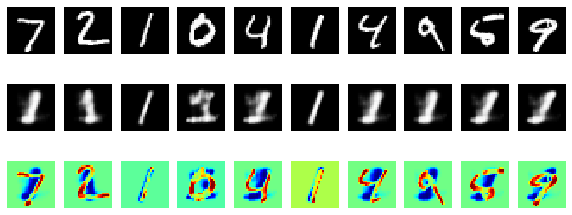これまで、KerasでAutoEncoderとか、KerasでAutoEncoderその2とかの記事を書いてきたんだけれど、これをGoogle Colaboratoryで動かしてみようか、というココロミについて。
Google Colaboratoryで動かせば、GPUが使えるのが大きい。
目的
- 手書きの数字の「1」を学習する
- 手書きの「1以外の数字」が入力された際に、その画像が「1」とは何やら違う、ということを示す
まずは、KerasでAutoEncoderその2で書いたネタを、tensorflowのKerasで動作するようにするのがゴール。
Colab上で実装する
Colabでpip install -U Kerasしようかと思ったけれど、tf.kerasを使うことにする。
まずは、Colabの「ファイル」メニューで「Python3の新しいノートブック」を選択して、ノートブックを作成する。後は、Jupyter Notebook上での作業と本質的には変わらない。
宣言部
import tensorflow as tf
import tensorflow.keras.backend as K
MNISTのダウンロードと前処理
mnist = tf.keras.datasets.mnist
(x_train, y_train), (x_test, y_test) = mnist.load_data()
image_size = x_train.shape[1]
import numpy as np
x_train = x_train.astype('float32')/255.
x_test = x_test.astype('float32')/255.
x_train = np.reshape(x_train, (len(x_train), image_size, image_size, 1))
x_test = np.reshape(x_test, (len(x_test), image_size, image_size, 1))
上述した目的に従い、「1」のみを学習させたいので、x_trainの中身を「1」だけにしておく。
x_train = x_train[y_train==1]
学習時のバリデーション用に、x_trainを更に分割して、x_validを作っておく。
学習時のバリデーションにx_testを使えば良いという考え方もあるけれど、自分はx_testは学習後の評価時に使うもんなんじゃないか?と思っている。
from sklearn.model_selection import train_test_split
x_train, x_valid, y_train, y_valid = train_test_split(x_train, y_train, test_size=0.175)
よく使う変数の設定
この後よく使う変数を設定しておく。
input_shape = (image_size, image_size, 1)
batch_size = 64
kernel_size = 3
filters = 16
latent_dim = 2
epochs = 50
encoder、潜在変数z、decoderを定義する
encoderをKerasのsampleにあった書き方で。
inputs = tf.keras.layers.Input(shape=input_shape, name='encoder_input')
x = inputs
for i in range(2):
filters *= 2
x = tf.keras.layers.Conv2D(filters=filters,
kernel_size=kernel_size,
activation='relu',
strides=2,
padding='same')(x)
shape = K.int_shape(x)
x = tf.keras.layers.Flatten()(x)
x = tf.keras.layers.Dense(16, activation='relu')(x)
潜在変数zと、そのためのsampling()の定義。
def sampling(args):
z_mean, z_log_var = args
batch = K.shape(z_mean)[0]
dim = K.int_shape(z_mean)[1]
epsilon = K.random_normal(shape=(batch, dim))
return z_mean + K.exp(0.5 * z_log_var) * epsilon
z_mean = tf.keras.layers.Dense(latent_dim, name='z_mean')(x)
z_log_var = tf.keras.layers.Dense(latent_dim, name='z_log_var')(x)
z = tf.keras.layers.Lambda(sampling, name='z')([z_mean, z_log_var])
いよいよ、encoderを定義する。
encoder = tf.keras.models.Model(inputs, [z_mean, z_log_var, z], name='encoder')
ここで、encoder.summary()すると、次のようになる。
__________________________________________________________________________________________________
Layer (type) Output Shape Param # Connected to
==================================================================================================
encoder_input (InputLayer) (None, 28, 28, 1) 0
__________________________________________________________________________________________________
conv2d (Conv2D) (None, 14, 14, 32) 320 encoder_input[0][0]
__________________________________________________________________________________________________
conv2d_1 (Conv2D) (None, 7, 7, 64) 18496 conv2d[0][0]
__________________________________________________________________________________________________
flatten (Flatten) (None, 3136) 0 conv2d_1[0][0]
__________________________________________________________________________________________________
dense (Dense) (None, 16) 50192 flatten[0][0]
__________________________________________________________________________________________________
z_mean (Dense) (None, 2) 34 dense[0][0]
__________________________________________________________________________________________________
z_log_var (Dense) (None, 2) 34 dense[0][0]
__________________________________________________________________________________________________
z (Lambda) (None, 2) 0 z_mean[0][0]
z_log_var[0][0]
==================================================================================================
Total params: 69,076
Trainable params: 69,076
Non-trainable params: 0
______________________________________________________________________________________________
引き続き、decoderを定義する。
latent_inputs = tf.keras.layers.Input(shape=(latent_dim,), name='z_sampling')
x = tf.keras.layers.Dense(shape[1]*shape[2]*shape[3], activation='relu')(latent_inputs)
x = tf.keras.layers.Reshape((shape[1], shape[2], shape[3]))(x)
for i in range(2):
x = tf.keras.layers.Conv2DTranspose(filters=filters,
kernel_size=kernel_size,
activation='relu',
strides=2,
padding='same')(x)
filters //= 2
outputs = tf.keras.layers.Conv2DTranspose(filters=1,
kernel_size=kernel_size,
activation='sigmoid',
padding='same',
name='decoder_output')(x)
decoder = tf.keras.models.Model(latent_inputs, outputs, name='decoder')
ここで、decoder.summary()すると、次のようになる。
_________________________________________________________________
Layer (type) Output Shape Param #
=================================================================
z_sampling (InputLayer) (None, 2) 0
_________________________________________________________________
dense_1 (Dense) (None, 3136) 9408
_________________________________________________________________
reshape (Reshape) (None, 7, 7, 64) 0
_________________________________________________________________
conv2d_transpose (Conv2DTran (None, 14, 14, 64) 36928
_________________________________________________________________
conv2d_transpose_1 (Conv2DTr (None, 28, 28, 32) 18464
_________________________________________________________________
decoder_output (Conv2DTransp (None, 28, 28, 1) 289
=================================================================
Total params: 65,089
Trainable params: 65,089
Non-trainable params: 0
_________________________________________________________________
これで、encoderとdecoderが逆のネットワーク構造になっていることが確認できた。
以上を踏まえて、Variational Autoencoderモデルを次のように定義する。
outputs = decoder(encoder(inputs)[2])
autoencoder = tf.keras.models.Model(inputs, outputs, name='vae')
loss関数の定義
loss関数を、Kerasのsampleに記載されていたように定義する。
rx_loss = tf.keras.losses.binary_crossentropy(K.flatten(inputs), K.flatten(outputs))
rx_loss *= image_size*image_size
kl_loss = 1+z_log_var-K.square(z_mean)-K.exp(z_log_var)
kl_loss = K.sum(kl_loss, axis=-1)
kl_loss *= -0.5
vae_loss = K.mean(rx_loss+kl_loss)
autoencoder.add_loss(vae_loss)
最適化関数の設定
最適化はAdamで行う。なんとなく、学習率だけ、デフォルトより小さい値にしてみる。
from tensorflow.keras.optimizers import Adam
adam = Adam(lr=0.0001)
autoencoder.compile(optimizer=adam)
学習の実施
実行に要した時間を表示するようにしておく。
import time
start_time = time.time()
autoencoder.fit(x_train,
epochs=epochs,
batch_size=batch_size,
validation_data = (x_valid, None))
print('{:.2f}[sec]'.format(time.time()-start_time))
50 epochsを実行してみた結果、79.28秒だった。GPU速い。自宅のMacBook Pro (Mid2012)だと、10分弱くらいかかる。Colab上でも666.18秒かかった。
学習結果の確認
x_testの先頭10データを入力してみる。入力値から得られた特徴量を「1」のモノだと思って復元を試みるので、入力した画像と復元した画像との間で差異が小さければ「1」だろうし、大きければ「1以外の数値」である。
潜在変数zが今回2次元なので、その分布を図示して、学習した「1」の分布の重心等代表値と、入力した画像から求めたzとの距離を数値化するだけでも良いかもしれない。
from matplotlib.pyplot as plt
%matplotlib inline
import cv2
n = 10
decoded_imgs = autoencoder.predict(x_test[:n])
plt.figure(figsize=(10, 4))
for i in range(n):+1:
# original_image
orig_img = x_test[i].reshape(image_size, image_size)
# reconstructed_image
reconst_img = decoded_imgs[i].reshape(image_size, image_size)
# diff image
diff_img = ((orig_img - reconst_img)+2)/4
diff_img = (diff_img*255).astype(np.uint8)
orig_img = (orig_img*255).astype(np.uint8)
reconst_img = (reconst_img*255).astype(np.uint8)
diff_img_color = cv2.applyColorMap(diff_img, cv2.COLORMAP_JET)
# display original
ax = plt.subplot(3, n, i + 1)
plt.imshow(orig_img, cmap=plt.cm.gray)
ax.get_xaxis().set_visible(False)
ax.get_yaxis().set_visible(False)
# display reconstruction
ax = plt.subplot(3, n, i + n + 1)
plt.imshow(reconst_img, cmap=plt.cm.gray)
ax.get_xaxis().set_visible(False)
ax.get_yaxis().set_visible(False)
# display diff
ax = plt.subplot(3, n, i + n*2 + 1)
plt.imshow(diff_img, cmap=plt.cm.jet)
ax.get_xaxis().set_visible(False)
ax.get_yaxis().set_visible(False)
plt.show()
上段が、入力画像で、中段がautoencoderを使って、上段の画像を基に生成した画像で、下段が上段と中段の差分である。
「1」以外が入力されたときに、無理やり「1」を復元しようとして破綻していることが可視化された。
というワケで、KerasでAutoEncoderその2そのまんまなんだけれど、CoLabでGPUを使ってみたかったというハナシ。
